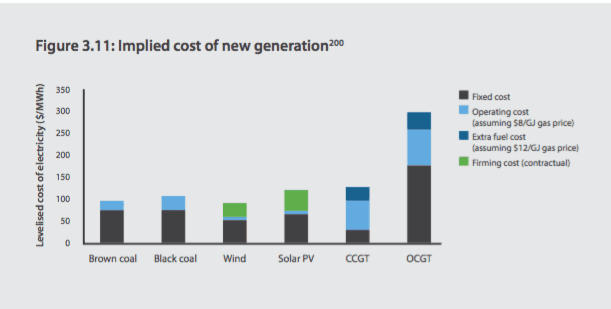Chief scientist Alan Finkel’s plans for Australia’s energy future – and a new mechanism called a “clean energy target” – appears to throw a lifeline to the Australian coal generation industry, but basically throws the gas generation sector to the wolves.
Modelling done by the Finkel review actually shows the share of coal generation would be double that than would occur under “business as usual”. The gas generation industry is devastated, at least compared to business as usual.
Under the scenario, coal fired generation is still providing one quarter of Australia’s electricity generation by 2050, with the Finkel Review only contemplating the Coalition target of reaching zero emissions by 2050.
That is more than business as usual (19 per cent) and implies that some coal generation will continue to operate past their current use by date.
Indeed, the modelling for the Finkel Review says renewable energy will account for 42 per cent of total generation, but this includes the 9 per cent from rooftop solar. Large scale renewable energy will increase to only 33 per cent over the decade to 2030 from around 23.5 per cent in 2020, when the renewable energy target is met..
By 2050, the modelling suggests, large scale renewables will rise to 62 per cent, with another 11 per cent from rooftop solar, suggesting some sort of slow down in the share of rooftop capacity.
It contrasts sharply with the predictions of the CSIRO, which saw nearly half of all generation from rooftop solar by that time, and more than 90 per cent overall from renewable energy.
Environment Victoria says the suggestion that there will be no significant decrease in output from brown coal generators before 2030 is fanciful. “Yallourn and the Loy Yang power stations are the dirtiest power stations in the country and can’t keep polluting indefinitely,” it says.
Another interesting point is that the modelling suggest that under a CET as currently modelled large scale solar will only provide half the output of the wind industry, which might surprise many.
This is despite the fact that Finkel’s own conclusions are that wind and solar are by far the cheapest new technologies, and even with storage or “firming costs” comfortably beat gas generation. Brown coal is just competitive with solar, but this does not include carbon or environmental costs.
“The Panel notes that, even since the Review started, utility scale batteries, wind and solar photovoltaic have declined in cost substantially more than expected,” it says, noting the Origin Energy deal on the Stockyard Hill Wind Farm (about $55/MWh) and the AGL assessment that a new wind farm supported by existing gas peaking generation (through a “firming cost’) to now be cheaper than new baseload gas at a $8/GJ price, and a new solar farm supported by gas peaking generation would also be cheaper than new CCGT at a gas price of $12/GJ.











